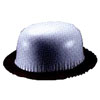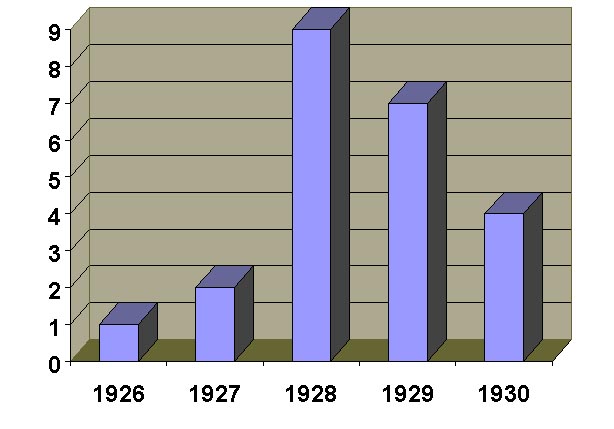 Bix's
Muted Solos
Bix's
Muted Solos 
In
his six-year recording career (1924-1930), Bix Beiderbecke recorded a
total of approximately 120 solos. In 25 of the solos Bix
used a straight or Harmon mute or a Derby. Bix's first solo using
a derby was in 1926. Thus, for the first three years, Bix used
a mute/derby only once. However, as time passed, Bix made use of mutes
more and more frequently.
First, I list all recordings where Bix uses a mute or a derby in his solo.
1924-1926
Oct 12, 1926. Jean Goldkette, Idolizin’.
1927
Aug 25 1927. Frank Trumbauer, Blue River.
Nov 23 1927. Paul Whiteman, Changes.
1928
Feb 28 1928. Paul Whiteman, Sugar.
Apr 22 1928. Paul Whiteman, Forget-Me Not.
Apr 25 1928. Paul Whiteman, You Took Advantage Of Me.
Apr 28 1928. Paul Whiteman, Louisiana..
May 15 1928. Paul Whiteman, My Melancholy Baby.
Jun 10 1928. Paul Whiteman, ’Tain’t So, Honey, ‘Tain’t So.
Sep 18 1928. Paul Whiteman, Gypsy.
Sep 18 1928. Paul Whiteman, Sweet Sue.
Oct 05 1928. Frank Trumbauer, Sentimental Baby.
1929
Apr 05 1929. Paul Whiteman, I’m In Seventh Heaven
Apr 17 1929. Frank Trumbauer, Wait Till You See “Ma Cherie”.
Apr 17 1929. Frank Trumbauer, Baby Won’t You Please Come Home.
Apr 30 1929. Frank Trumbauer, No One Can Take Your Place.
Apr 30, 1929. Frank Trumbauer I Like That.
May 03 1929. Paul Whiteman, China Boy.
May 04 1929. Paul Whiteman, Oh! Miss Hannah.
1930
May 21 1930. Hoagy Carmichael, Rocking Chair.
May 21 1930. Hoagy Carmichael, Barnacle Bill, the Sailor.
Sep 08 1930. Bix Beiderbecke, I’ll Be A Friend "With Pleasure".
Sep 15 1930. Hoagy Carmichael, Georgia On My Mind.
In order to draw some inferences fom this data, it is instructive to represent it graphically. The following graph gives the number of muted solos as a function of year.

It will be seen that the number of muted solos reached a peak in 1928. However, in order to provide a sound interpretation of these data, they must be normalized. Bix recorded output varied considerably from year to year.
The following graph gives the total number of solos recorded by Bix as function of year. In the entry for 1926, I included also the solos recorded in 1924 and 1925. [There were so few recordings in 1926 that the single recording with a muted solo by Bix would distort the significance of the data.]

The general trend observed for muted solos also obtains for total solos, although quantitatively the variations are dissimilar. Just as with the number of muted solos, a peak is reached in 1928.
In order to make any inferences, as indicated above, the data must be normalized. I have done that by plotting the percentage of muted solos (out of the total number of solos in a given year, except for 1926 where all solos recorded in 1924-1926 are included). The results are depicted in the following graph.

For the normalized data, the peak is reached in 1929, when more than 60 % of the solos were played in a mute/derby. It is noteworthy that up to 1929, Bix made limited use of the mute/derby, whereas in 1929-1930, Bix made considerable use of it.
The significance of the data is pretty clear. As Bix's health deteriorated, he relied more and more on the mute/derby to conceal his weakness. It is interesting that the percentage of muted solos is higher in 1929 than in 1930. In fact, the trend goes along with what we know about Bix's health. In the first half of 1929, Bix was in very poor health. He had had a bout of pneumonia in late 1928-early 1929. He spent the month of February in Davenport recuperating. In contrast, in 1930, Bix, although probably still weak, was in better physical conditions than in 1929: he had undergone detoxification in late 1929, and was reported to be on the wagon for several months.
This file was uploaded on July 9, 2005
Return to the homepage of the Bixography
First, I list all recordings where Bix uses a mute or a derby in his solo.
1924-1926
Oct 12, 1926. Jean Goldkette, Idolizin’.
1927
Aug 25 1927. Frank Trumbauer, Blue River.
Nov 23 1927. Paul Whiteman, Changes.
1928
Feb 28 1928. Paul Whiteman, Sugar.
Apr 22 1928. Paul Whiteman, Forget-Me Not.
Apr 25 1928. Paul Whiteman, You Took Advantage Of Me.
Apr 28 1928. Paul Whiteman, Louisiana..
May 15 1928. Paul Whiteman, My Melancholy Baby.
Jun 10 1928. Paul Whiteman, ’Tain’t So, Honey, ‘Tain’t So.
Sep 18 1928. Paul Whiteman, Gypsy.
Sep 18 1928. Paul Whiteman, Sweet Sue.
Oct 05 1928. Frank Trumbauer, Sentimental Baby.
1929
Apr 05 1929. Paul Whiteman, I’m In Seventh Heaven
Apr 17 1929. Frank Trumbauer, Wait Till You See “Ma Cherie”.
Apr 17 1929. Frank Trumbauer, Baby Won’t You Please Come Home.
Apr 30 1929. Frank Trumbauer, No One Can Take Your Place.
Apr 30, 1929. Frank Trumbauer I Like That.
May 03 1929. Paul Whiteman, China Boy.
May 04 1929. Paul Whiteman, Oh! Miss Hannah.
1930
May 21 1930. Hoagy Carmichael, Rocking Chair.
May 21 1930. Hoagy Carmichael, Barnacle Bill, the Sailor.
Sep 08 1930. Bix Beiderbecke, I’ll Be A Friend "With Pleasure".
Sep 15 1930. Hoagy Carmichael, Georgia On My Mind.
In order to draw some inferences fom this data, it is instructive to represent it graphically. The following graph gives the number of muted solos as a function of year.

It will be seen that the number of muted solos reached a peak in 1928. However, in order to provide a sound interpretation of these data, they must be normalized. Bix recorded output varied considerably from year to year.
The following graph gives the total number of solos recorded by Bix as function of year. In the entry for 1926, I included also the solos recorded in 1924 and 1925. [There were so few recordings in 1926 that the single recording with a muted solo by Bix would distort the significance of the data.]
The general trend observed for muted solos also obtains for total solos, although quantitatively the variations are dissimilar. Just as with the number of muted solos, a peak is reached in 1928.
In order to make any inferences, as indicated above, the data must be normalized. I have done that by plotting the percentage of muted solos (out of the total number of solos in a given year, except for 1926 where all solos recorded in 1924-1926 are included). The results are depicted in the following graph.
For the normalized data, the peak is reached in 1929, when more than 60 % of the solos were played in a mute/derby. It is noteworthy that up to 1929, Bix made limited use of the mute/derby, whereas in 1929-1930, Bix made considerable use of it.
The significance of the data is pretty clear. As Bix's health deteriorated, he relied more and more on the mute/derby to conceal his weakness. It is interesting that the percentage of muted solos is higher in 1929 than in 1930. In fact, the trend goes along with what we know about Bix's health. In the first half of 1929, Bix was in very poor health. He had had a bout of pneumonia in late 1928-early 1929. He spent the month of February in Davenport recuperating. In contrast, in 1930, Bix, although probably still weak, was in better physical conditions than in 1929: he had undergone detoxification in late 1929, and was reported to be on the wagon for several months.
This file was uploaded on July 9, 2005
Return to the homepage of the Bixography